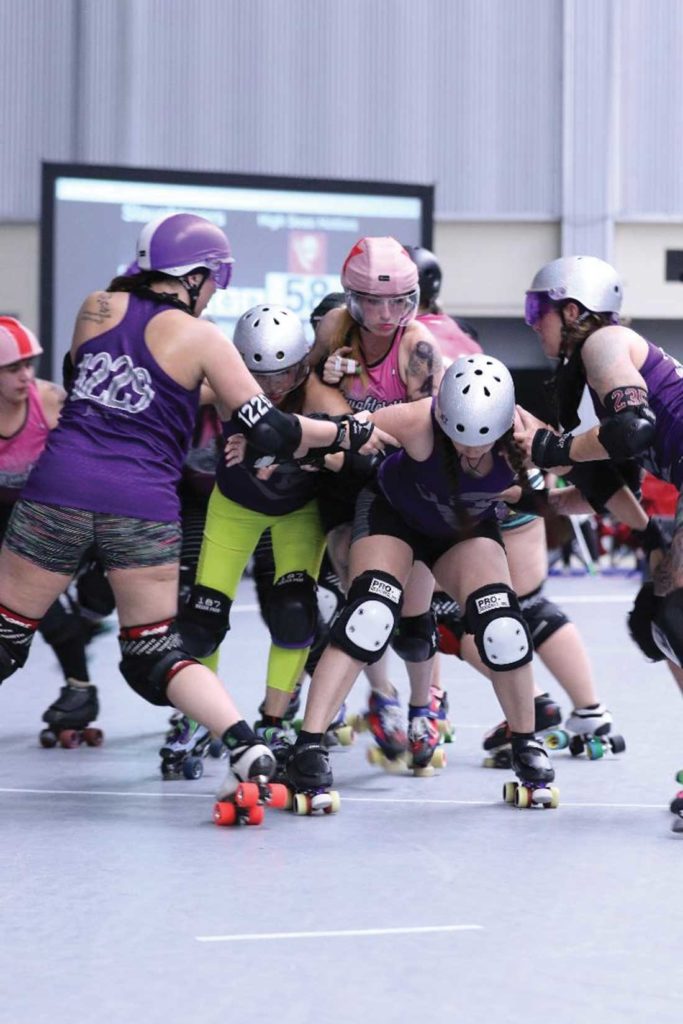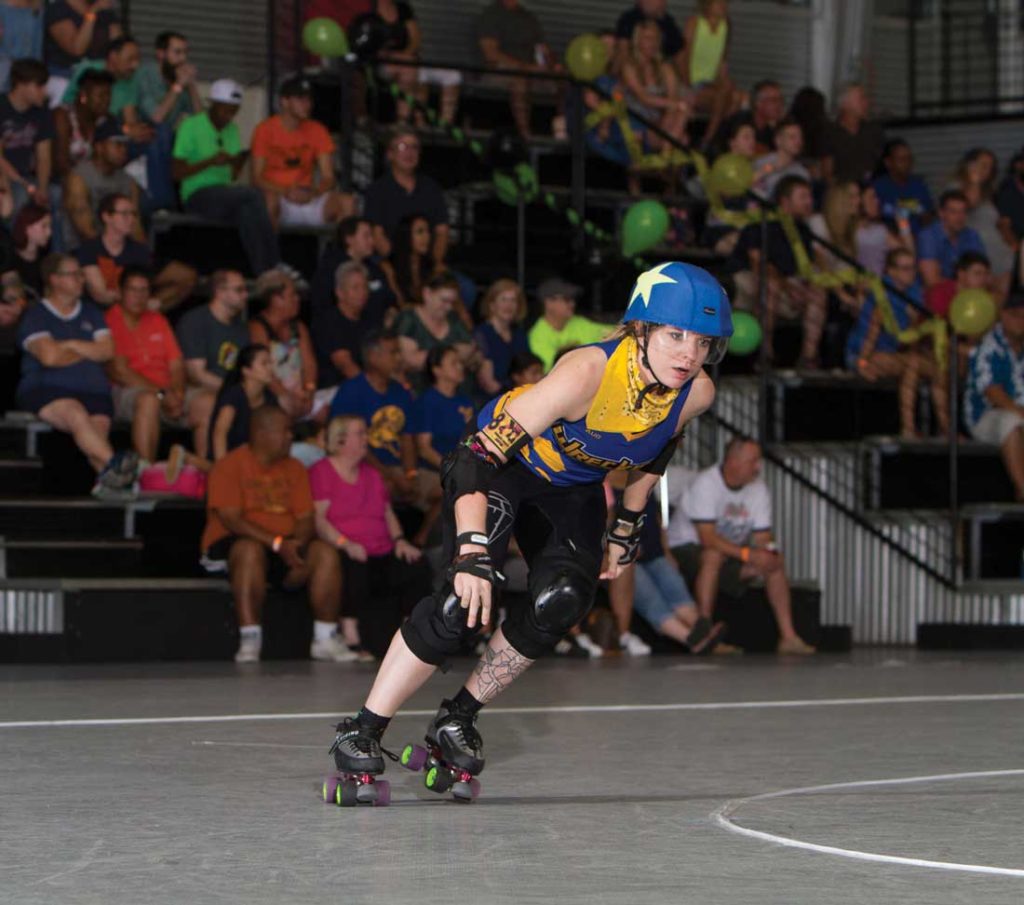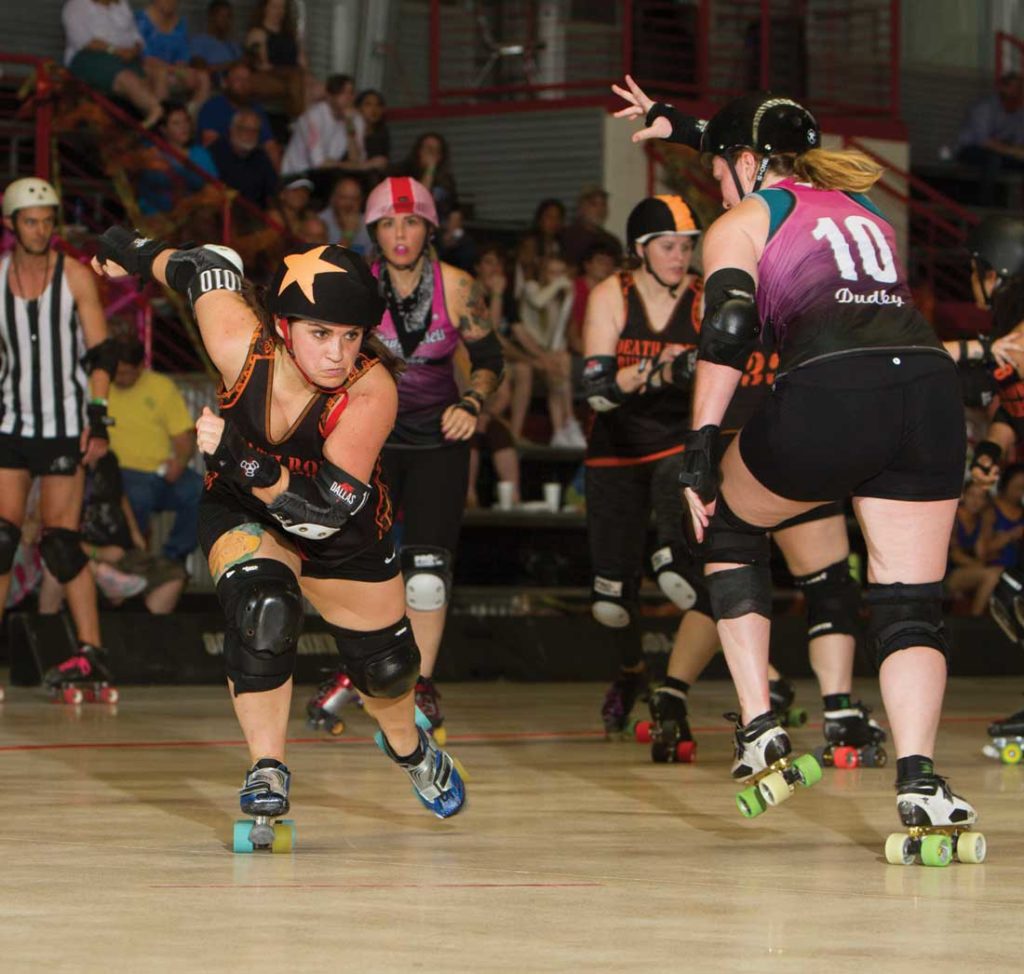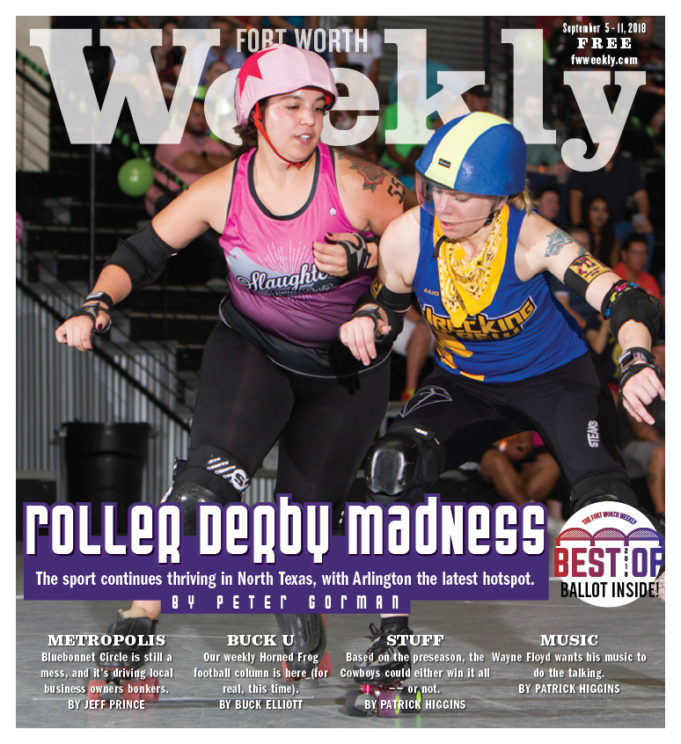Two teams line up on an oval track. Four blockers wearing team uniforms, quad skates and protected by helmets, kneepads, and elbow and wrist pads, stand with arms locked in front of four blockers from the opposing team. Ten feet behind the two sets of blockers stand two jammers — scorers — identified by a cloth helmet covering with a large star on it. At the referee’s whistle, elbows come out, and skates lock into place on the floor as the blockers vie to break each other’s arm locks. The inside game is instantly fierce. The two jammers skate into the blockers, trying to make their way through. They will score points only if they break out of the pack, circle the track, and lap the opposing team’s players. The blockers are simultaneously playing on the offensive for their own jammer, trying to get her an opening on the track, while also playing defense, trying to prevent the opposing team’s jammer from breaking through them. It’s a furious melee that looks something like a rugby scrimmage on skates.
Suddenly, the jammer for the Death Row Rumblers breaks free and begins to circle the flat track, her skates flying. As she approaches the blockers, she slows, looking for an opening her team might have created for her. Bazooka Bubble Bum crouches low, almost disappearing from view, crosses from the inside to the outside of the track, then breaks free and stands up tall once she’s passed the pack. For every opposing player she passes, she scores a point. If she laps the opposing jammer, she can rack up five points on a single turn around the track.
The opposing team’s blockers furiously try to stop her forward momentum, thrusting their chests and hips out, trying to knock her off the track. Sometimes they simply surround her, preventing any forward movement.
But then the jammer for the Suicide Shifters breaks free and begins to circle the track. She looks good, but her fight for freedom has cost her a lot of wind. She’s easily trapped by the Rumblers’ blockers. Bazooka is beginning to race around the track effortlessly, skipping past the Shifters’ blockers, ducking, moving inside and outside, racking up more than 20 points in the two minutes the jam lasts.
Score at the end of the first half: 262-32. Not a good showing for the Suicide Shifters. Game final: 502-101. While most of the scoring was done by Bazooka Bubble Bum — who also plays on the league’s traveling all-star team and the all-Texas team that competes against all-star teams from other states — the lopsided lead allowed the Rumblers to pass the star helmet covering to every player on the team during the game. The announcer noted, “Every single skater on the Rumblers scored points today. That’s something I’ve never seen before.”
Several of the players in the game agreed. They also said that while lopsided victories are not uncommon, scoring 500 points is almost unheard of.
It is probably fair to say that it’s something most people in North Texas have never seen. We could also probably say that most people in North Texas have no idea that there is an active roller derby league in the area. They would be more surprised to know that there are actually two leagues centered in Dallas, another in Arlington, a fourth in Denton, and a budding league trying to get on its feet in Burleson.
Most of the leagues have more than 100 skaters, referees, coaches, announcers, and adjunct personnel, making roller derby a very big secret. In the 16 years since I’ve lived in the area, and the dozen years that I’ve worked for the Fort Worth Weekly, I never heard of a roller derby here. And when I did, and went to a game, I was amazed. The players came in all shapes and sizes, but most of them are obviously very good athletes. Some of the skaters were simply amazingly quick and agile, able to dance around some blockers, smash through others, take hard hits and not give ground. I thought back to seeing the roller derby on television in the late 1950s and 1960s but thought it had died, so to learn how many athletes and other people are involved in the sport in my own area, and realizing I had no clue about it, well, I wanted to find out what it was all about and how it had apparently stayed under the radar for not just me but for every person I asked about it. It seemed to me that it would be like living in New York City or Philadelphia and not knowing that there was a sport called handball. How could you miss that? And yet I did.
*****

Roller derby’s roots reach back to 1935, when film publicist Leo Seltzer decided to combine the old dance marathons — where desperate people competed for money prizes by dancing for days — with roller skating, coming up with the idea of a Transcontinental Roller Derby. The object was to have teams of two skaters in front of an audience continuously circle a track until they logged 3,000 miles. Teams were disqualified the moment both skaters on a team were off the track.
Seltzer later had a portable track made and toured the country with it, putting on roller derbies across the United States. According to USA Roller Sports, one of the two primary roller derby organizations in the world, there were “occasional collisions and crashes, and this quickly became the most exciting part. Realizing this, sportswriter Damon Runyon encouraged Seltzer to change the game to incorporate more physical contact between the skaters.”
Over time, the derby evolved into a sport with two teams made up of five players on the track at a given time, with points being scored for lapping opposing players.
By the 1950s, the derbies that we saw on television were played on banked tracks, and the physicality came to resemble professional wrestling, with choreographed brutality the featured element. Those derbies lasted well into the 1970s, but the sport’s viewer base dwindled to the point where it was near dead by the early 1980s.
By 2001, however, the sport took on new life, reinvented as a flat track sport in Austin. The game was played and run by women, with an emphasis on athleticism, quality skating, and a dash of counter culture levity.
Locally, the earliest league was the Dallas Derby Devils, formed in November 2004. They were quickly followed by the Assassination City Roller Derby (named after the assassination of President John F. Kennedy), which was formed in February 2005. The North Texas Roller Derby, out of Denton, was formed in 2011, and the Arlington Derby Avengers started up in 2015.
The Burleson Derby Babes league is still struggling. A spokesperson told me, “We are not an active league. We just didn’t have enough interest for a full league. We’d hold practices, and only a handful of players would show up. But we’re hopeful for next year. We will get up and skating.”
The Derby Devils, who play in North Richland Hills, Assassination City, currently playing in Plano, and the North Texas league out of Denton are all members of the international Women’s Flat Track Derby Association, which has more than 450 leagues worldwide. The Derby Avengers play in the USA Roller Sports organization, which has more than 1,500 leagues in 40 countries.
While there are some rule differences between the two umbrella organizations — most notably in that the USARS is a faster league with fewer game stoppages — the tracks, game length, and scoring are the same. Tracks are generally wooden — think: bowling alley — with an inside line that is a perfect oval, 25 feet across and 60 feet long. Track width is generally 13 feet but expands out to 15 feet near the turns, making the outside line irregular.
Skating is done counter-clockwise, and at the start of each “jam” – 90 seconds in USARS and two minutes in WIFDA – the jammers stand side by side behind the two lines of four blockers from each team. The jammers wear the starred helmet covering, and only they can score, with one exception: Each team has one blocker who wears a helmet covering with a colorful stripe down the middle. She is known as the “pivot.” If a jammer simply cannot break free, she can pull the star covering off her helmet and pass it to the pivot, who puts it on and becomes the jammer for the remainder of that jam. The former jammer becomes a blocker. If a jammer is knocked out of bounds, with either skate touching down outside the track, she can reenter the track, but she has to do so behind the last skater on the other team.
Thirty-second penalties, which require the skater to leave the track, are called for a variety of reasons but most often for tripping or the use of elbows or knees. Being one skater short for 30 seconds gives the opposing team a huge advantage.
As many as seven referees call each game. One ref follows each jammer, two check the inbounds on both the inside and outside of the track, one checks the jam time, and two look for penalties.
The players are not paid. In fact, they all pay monthly dues to pay for rink time and are responsible for all their own gear, though some of the best skaters acquire sponsorships from gear companies.
“The gear comes to quite a bit,” said Destiny Saxiones, who, with her mother, started and runs the Arlington league. “There’s the team jersey, the helmet, mouth guard, wrist guards, elbow and knee pads, and then skates, which are a story of their own. They can run up to about $700, but then things go wrong all the time, from ball bearings going bad to toe guards wearing down. You have to really want to play to make the investment necessary.”
*****
The longest-playing local player is Anita Schuring, who goes by the name Anita Riot. She joined the Dallas Derby Devils in early 2005, when the league was just six months old. “Early on, we all did it all. I was picked as a jammer because I had speed and stamina. I did mostly that for 13 years, but this year I mostly play pivot.”

Riot, who is a member of the Wrecking Crew as well as a member of the all-star team, had just come back from an all-star tournament in Wisconsin when I talked with her. “We won all three of our games. We beat Madison first by 12 points, then a team called Naptown and won that by three. Our last match was against a team from Tucson, Arizona, and we won that by over 100.”
While she says she loved her speed days as a jammer, she also loves being a pivot, where her primary job is as a blocker. “As a pivot, you want to be so good as a blocker that your jammer never needs to pass the star to you. You’re just there as an emergency valve, and if you get the star, it means your jammer isn’t scoring.”
She finds it exhilarating to be out there blocking. “When your goal is to knock someone down, and then you do it, you feel like you’re in the zone. It’s really the same as with any sport: When it goes the way you practiced it, just right, well, that’s a very satisfying moment, a really good spike in adrenalin and a spike in endorphins as well.”
She said she first learned of roller derby while she was working as a bank teller and was handed a flyer. “I called the number out of curiosity and told the woman who answered that I didn’t even know what roller derby was. She told me to come to practice to see what I thought. And I love it. I’d grown up with inline skates, so I had to relearn quads, and I didn’t even have a helmet for a month. But by the second month, I had everything I needed and was starting to play. It just got more intense from there.”
Riot said the sport has always been a physical challenge. “I played volleyball and soccer and other sports as a kid, but roller derby takes all the skills of all those other games. And it is physically exhausting.”
She admitted that at 33 she is “a little more tired” after tournaments than she was in her 20s but said it is still worth it. “I’ll keep doing it as long as I am able. I just love playing.”
She is not alone. Kim Villars came to the sport after she and her young daughter saw the Derby Devils marching in a parade. Villars, who goes by the name Ms. Ripper when playing with the High Seas Hotties, then went to a game with her daughter. That’s when the girl said she ought to try out. “You know, I sometimes trip just walking across the floor,” Villars said, “but when I strap on those skates, I can sure hit some people. And that feels good.”
Like Anita Riot, Amanda Brennan, a.k.a. Bazooka Bubble Bum, is one of the stars of the Derby Devils. She first heard of the derby from a coworker several years ago. Brennan, who works with human resources data for a large local company by day, said she had always skated but was intimidated initially because there were no rookie programs in the league at the time.
“But even without the rookie program that we have now, it turned out alright,” she said. “We moved around a lot when I was a kid, and the one constant was that every town had a skating rink, and mom would drop me off there, and I learned to skate really well, so when I went to the derby, the muscle memory came back.”

That muscle memory was aided by a background in high school cheerleading and competitive soccer. “The soccer helped me develop speed and endurance, two things you’ve got to have as a jammer, but the cheerleading helped tremendously with lateral movement and with moving to different levels, from low to high. Even now my practices consist largely of dance moves.”
Brennan is not as tiny as most jammers, but she views that as a strength rather than a drawback. “I’m thick, and I get underestimated. I’m a great skater, but I’m also strong enough to move the pack.”
When she is forced to occasionally pass the star to a pivot and become a blocker, she is not as confident in her skills. “My blocking skills are just not equal to my jamming skills. Jamming requires quick thinking and fast decisions. Blocking involves interacting with three other people and strategy, and if you’re not in sync with them, you’ll fail as a blocker. A jammer is more a solo act.”
Angela Beard, a licensed clinical psychologist who goes by Gory Midori, is a former player who is now a referee. It was 10 years from the time she first had interest in joining the derby until she finally did it. “I was moving around, going to graduate school, but I finally did try out and was glad I did. I knew it would interest me because it has a counter culture element that attracts me, and it has this element of female empowerment, which was extremely valuable to me.”
She’s a feminist, she said, “and seeing the dynamic of a sport completely dominated by women, from coaches on down, well, that’s incredibly fascinating. I’ve never seen that model before.”
She played two years with the Alamo City Roller Girls out of San Antonio but couldn’t make the time commitment, so she switched to refereeing. “When you’re playing, you have two to four two-hour practices weekly, aside from your own personal practice time, and if you want to excel, you do the four a week because you have an obligation to your teammates and don’t have the option to flake out. I just could not commit that time. With refereeing, they’re grateful you are on board, so things are more flexible.”
There is no school as yet for referees, Beard said, though there is an effort to charter a program. “So you wind up doing a lot of shadowing at games, and you’ve got multiple refs giving advice, correcting you, making you better. And you want to be better. Involvement in the roller derby involves initiative because we’re all volunteers, none of us are paid, and we work hard to be in a sport that’s not widely known.”
*****
The Arlington Derby Avengers league was founded three years ago and is currently in the midst of its first home season. It’s been a hard uphill climb to reach this point, said co-owner/cofounder Saxiones.
“When I was 10 or 11, my mom skated with Assassination City Roller Derby and then went to the Dallas Derby Devils, so I grew up wanting to do derby,” said the 22-year-old Saxiones, who goes by Daisy Deathwish on the track.
She planned on joining a league after graduating from Baylor University, which she just did, but a horrible event pushed her to move up her timetable.
“I was sexually assaulted by a guy I’d previously dated, and it left me afraid to go out,” she said. “My head got into a bad space, so I thought I needed to get strong again and told my mom I wanted to do roller derby because those were such strong women. And my mom told me she wanted to start a league and did I want to make it a mother-daughter type of thing?”
The next time she came home from school for a weekend, she and her mom began drawing up their plans. They quickly came up with a name for the league, and after that the first order of business was finding a place to skate. They approached the owner of the Arlington Skatium who was more than willing to rent them space — except on Saturday nights, which was his big night but was also roller derby’s. “We knew we’d have to find another place to play games on Saturdays, but at least we had a practice space, so we put out word on Facebook for women who wanted to join a new league, and at our first meeting about 20 girls showed up. That’s where we started.”
From there, Saxiones and her mom started advertising with flyers and said they received a wonderful reception. Coaches asked to coach and photographers if they could take the league photos. “People were just excited about a new league and a new sport growing from the ground up right there in Arlington.”
Unfortunately, they lost a lot of their skaters due to finances and lost their rink when they could no longer afford it. “But we were determined to make the league work,” Saxiones said, “so we skated outdoors in parking lots and on basketball courts. It was so hot in the summer that it was unbearable.”
Enough skaters joined to have a makeshift game. They played it in the Texas summer heat. “It was hot, but enough people came to watch us that we knew we had a fan base, and that was something.”
They reached out to Super Dave at the Cedar Hill Roller Rink, the place they have called home the last year. “Our space is small, but we’re still getting 100 to 150 people at each game, so that’s not bad. We’re working on it.”
At $10 a ticket, it helps defray the cost of the space and allows the league to donate a portion of the receipts to charity.
“This year, our first full year with a real home, we have three teams,” Saxiones told me. “And that is going to grow.”
While she explains that the sport is rough — “We’re not here to maim you, but we do love to bruise you” — she is quick to add that it is a place where “you ruin your body to save your soul. We get bruised and hurt, but we grow as humans. We get strong. We get empowered. The best thing for me is to watch the players grow.”
One of the players she’s enjoyed the most is Journey Zimmerman, known as Baby J or Happy on the track. “Journey came to us when she was 15. She was homeschooled and had no idea how to interact with people, but she is 18 now, just had a baby — what’s called a ‘nine-month injury’ — and she’s grown enormously.”
Zimmerman was inspired by the 2009 roller derby movie Whip It.
“It’s a movie … about a girl in high school who went to a derby and fell in love with it and winds up getting recruited and finds her confidence, her domain, and her friends,” Zimmerman said.
The idea of friends appealed to her because she didn’t have any. “There were old neighbors I knew, but they weren’t my age, and I had a sister, but she was just a baby. Then I saw that someone wanted to start a league in Arlington, and I told my mom. Their first meeting was on January 17, 2015, and we went. I was so nervous. I wasn’t in any kind of shape but round. I knew how to skate but had no stamina. I mean, I was just 15 and didn’t know anyone. And it turned out I was the youngest one there.”
She went to the first couple of practices but stayed to herself, too timid to ask questions. “But then one practice, Destiny [Saxiones] came to me and helped me with something, and I realized I didn’t need to be afraid of her because she was there to help me. That was my first big breakthrough. And from there I kept growing. Derby helped me find my voice, taught me to be confident, and showed me who I am on and off the track. It’s shown me that I am a strong, independent person who can do anything I set my mind on doing.”
Zimmerman started the long path back to getting into playing shape on August 11. “That break to have my baby took a lot out of me. You lose your stamina. You lose your sharpness. I’m working hard to get those back.”
Destiny’s dad, Steve Saxiones, is one of a handful of men involved with the league. He’s a coach who describes the Arlington Derby Avengers as more a recreational league than the more serious Dallas Derby Devils. “Ours is still a beginner league. We bring girls in who don’t even know how to play and train them from the ground up.”
He initially became involved when his wife started kicking his butt on skates while she was with the Assassination City league. “I was a penalty timer in that league, but when my wife and daughter started this league, they had no reliable coach, so I stepped into that position.”
Helping to run the league is at times stressful. “There have been times when we have had to go into our own pocket for flyers, rental of the rink, a hundred other things, but you do it, and people come to the games, and that’s satisfying.”
One of the things he loves about the derby is that it is “very accepting of everyone. We don’t care about your politics, your sexuality, your race, religion, what you do in your daily life. So long as you strap on your skates, you are one of us.”
Which direction do you feel the league should take as it grows?
“We’re good and getting better. In 2016, I took our select girls and went to the nationals and lost first place by one point. That said, we want our league to put on a show. We want the derby love. We want to entertain you. That’s what we’re here for.”
Over at the Derby Devils, Brennan agrees that entertainment is important, but she also loves the reward of being part of a very competitive team. “The Dallas Derby Devils are currently ranked No. 27 in the world in our organization. We push people hard to get there and stay there, and we want to go higher. For us, it means more practice, more work, but then for us, it’s worth it.”












